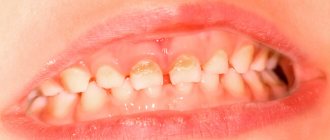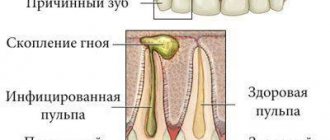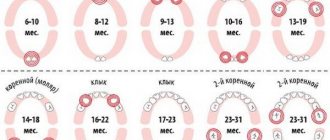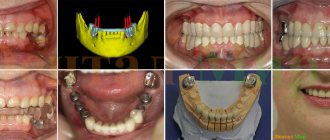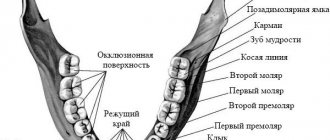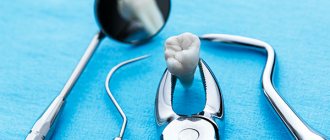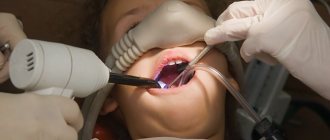Tooth loss is a disease in which, under the influence of negative factors, the integrity of the dentition is disrupted (due to the loss of one or more teeth). This disease is called edentulism.
Teeth are an important element of the human body. We lose them starting from childhood: healthy, strong teeth grow in place of lost milk teeth. Losing permanent teeth is a serious problem because a new tooth will not grow in the vacant space.
Caries
The most common cause of tooth loss is tooth decay. With this disease, the tooth crown is destroyed and the root system is weakened, as a result of which the tooth simply falls out. This happens if caries is not treated and oral hygiene is not maintained.
In this case, the tooth root, as a rule, remains in the bone tissue under the gum and if it is not removed in time, inflammation may develop.
To prevent tooth loss, you need to contact your dentist at the first signs of caries; these may be:
- the presence of carious cavities are dark spots on the tooth enamel. At the initial stage of the disease, they may not be present, or the patient may not see them on their own.
- pain when the tooth gets hot/cold, or sour, sweet or salty food and liquid;
- pain when pressing on the tooth and when chewing;
- bad breath;
- in the later stages - severe destruction of the crown.
Sealing
This method is indicated for chips that appear as a result of carious tooth decay, as well as for major damage to the tooth crown. In this case, radiographic examinations are often required. If the crown is significantly damaged, filling may be ineffective - the filling simply cannot last long. In this case, the doctor will offer alternative options.
If the pulp is damaged, filling alone may not be enough. First, the pulp is removed, treated and the root canals are filled. Then the crown of the tooth is restored using filling material or another method.
Periodontal disease
Periodontal disease is a disease that affects the gums and bone tissue around the tooth. With periodontal disease, atrophy of gum tissue occurs, so-called gum pockets are formed, and bacterial plaque is deposited in them, provoking further inflammation. The gums around the tooth shrink, exposing the lower part and, in some cases, the root. And the tooth itself gradually loosens and leaves the tooth socket.
Periodontal disease is often accompanied by inflammation, bad breath, sore gums, and increased tooth sensitivity.
But periodontal disease leads to tooth loss only in an advanced stage if measures are not taken for a long time. If you consult a doctor at the first signs of illness, unpleasant consequences can be avoided. And if you follow hygiene rules and do not overindulge in sweets, then the development of periodontal disease itself can be prevented.
Symptoms
Treatment of a small chip on the enamel of a tooth (front or back) should be started as early as possible. If the broken fragment is too small, it may not cause any discomfort, only aesthetic. This does not mean that you should neglect a visit to the doctor, since very soon the problem will grow to much more serious proportions, and therapy will be long and expensive.
Characteristic symptoms:
- visible cracks on the surface;
- loss of filling;
- exposed nerve endings;
- violation of the integrity of the coronal part;
- increased sensitivity to temperature changes;
- pain syndrome, especially at night.
Periodontitis
Periodontitis is an inflammation of the soft tissues of the oral cavity. If left untreated, it causes weakening of the ligamentous apparatus of the tooth. The gum becomes inflamed, destroyed, the fixation of the tooth in the socket is weakened, under the influence of regular chewing load it becomes loose and eventually falls out. Often with periodontitis, the tooth root is exposed.
Periodontitis causes not only poor oral health and bacteria, but also allergic reactions, gum injuries, hormonal imbalance, weakened immunity and a number of other reasons.
Moreover, if periodontitis is generalized, that is, spread over the entire jaw, the matter may not be limited to one lost tooth and other dental units will follow. If periodontitis is not treated at all, it can lead to complete edentia.
The first signs of the disease, for which you should go to the clinic, are bleeding gums, discomfort, and itching. This may be followed by pain when chewing, an unpleasant odor, and purulent discharge.
In severe periodontitis, the teeth become displaced and loosened, exposing the lower part of the tooth and the root. The disease should definitely not be brought to this stage, since it can only be cured through surgery.
Questions and answers
A year ago I received a serious facial injury, resulting in the loss of 2 front teeth on the upper jaw.
Good afternoon! A year ago I received a serious facial injury, which resulted in the loss of 2 front teeth on the upper jaw. The first is along with the root, but the root remains from the second. I am 43 years old, I live in Moscow. Will they be able to help me restore these teeth and how?
Hello! You can try to restore your teeth using express dental implantation or classic implantation; which method is right for you can be determined after an examination. There is also the option of restoring the dentition using classic dental prosthetics, but to determine whether this is possible in your case, again, an examination of the oral cavity and an x-ray are necessary. You can sign up for a free consultation with our specialists, where they will take an image and write out a treatment plan. Appointments can be made by calling +7 (495) 789-42-02 or. Sincerely, Patient Support Center SIMPLADENT++ 78
As a result of illness (fluorosis), he lost a large number of teeth. Orthopedists in our city offer removable dentures. Tell me, what prosthetic options are possible in my case?
As a result of illness (fluorosis), he lost a large number of teeth. Orthopedists in our city offer removable dentures. Tell me, what prosthetic options are possible in my case?
Hello! In your case, in order to recommend possible options for dental restoration, it is necessary to first analyze the image and also conduct an examination of the oral cavity. It is necessary to understand why you were not offered to have dental bridges or dentures on implants, why the orthopedist suggested that you install removable bridges. If you have such an opportunity, we suggest that you attend a free consultation at one of our clinics so that our doctors can conduct a direct examination, since a remote consultation still does not give the full picture. You can make an appointment with our specialists by calling the numbers listed below. Sincerely, Patient Support Center SIMPLADENT++ 78-800-333-53-41
Other questions
Other jobs
Age-related changes
If the main causes of adentia can be identified and neutralized in time, age-related tooth loss is an inevitable phenomenon. In old age, the immune system weakens, the gums atrophy and decrease in volume, the neck of the tooth becomes exposed, teeth become mobile and fall out.
Most often this happens at the age of 65-70, but if the patient did not take care of his teeth and did not follow preventive recommendations, negative consequences may appear earlier.
It is not possible to prevent this, but you can delay it by taking vitamins, medications that boost immunity, carefully monitor your physical condition and lead a healthy lifestyle.
Restoration of a chipped tooth: types of treatment and restoration of damage
In restorative dentistry, various methods of tooth restoration are used, depending on the type of injury, the nature of the defect, the location of the damaged tooth and the general health of the patient. In each specific clinical case, the method of tooth restoration is determined individually, but experts identify several main types of treatment for chipped teeth.
Remineralization
Remineralization is used as a method of partial restoration of tooth enamel with small defects and microcracks, for prophylaxis, to prevent the leaching of minerals and to strengthen the outer layer of the tooth. The surface is covered with a special solution containing micronutrients and enriched with minerals. Remineralization allows you to restore the protective properties of enamel.
Remineralization of tooth enamel
Fluoridation
Fluoridation is the application of medicinal preparations in the form of gels and varnishes with a high fluorine content to the damaged surface. The procedure is carried out in several stages and allows you to restore the integrity of the enamel in case of minor damage.
Building up
Extension is carried out in cases of moderate tooth trauma with partial dentin fracture; the procedure involves applying a special medical paste, fixing each layer using light radiation. When restoring in this way, a certain texture, color and shade of the building material is selected, which makes it possible to make the restored tooth practically indistinguishable from others. This technique has a relatively low cost and is effective, which has made extensions very popular.
Filling and microprosthetics
Filling and microprosthetics are used for extensive damage to dental tissue; in various cases, restoration is used using conventional fillings, stump and restoration inlays, veneers and lumineers, and in case of tooth loss, prosthetics on implants or the installation of artificial crowns are performed.
Microprosthetics of cracked teeth
For outgoing and public people, the appearance and attractiveness of a smile is often of great importance, so a chipped front tooth can become a real problem. For the restoration of teeth located in the frontal part of the dentition, onlays made of ceramics, porcelain or zirconium dioxide can be used, which are the best aesthetic solution. When using microprosthetics with veneers, you have to grind off a thin layer of enamel to make the overlay look as natural as possible; the procedure is quite unpleasant, but allows you to achieve maximum attractiveness. Lumineers are thinner, so their installation does not require grinding the enamel, but this type of lining is more vulnerable to mechanical damage. Onlays perfectly hide tooth defects and are used not only in case of chips, but also to restore aesthetic function to patients with crooked dentition and large gaps between teeth.
When restoring lateral teeth that are hidden from the eyes of others, visual appeal and beauty often fade into the background, so restoration can be performed using inlays, the main task of which is to reconstruct the integrity of the tooth and restore chewing function. Restorative inlays perform the same function as fillings, but for more extensive damage - they replenish the damaged or chipped part of the tooth, restore the original shape and relief of the dental unit. Stump inlays work on the principle of crowns - they restore the upper part of the tooth, which has preserved the root and base, but has a large affected area. Inlays are made from noble and base metals, metal alloys, which makes them wear-resistant and durable, and ceramic, metal-ceramic and light-polymer composite inlays are used to restore the color and shade of teeth. In some clinical cases, adhesive microprostheses made of fiberglass in the form of a beam can be used, which are attached to notches on adjacent teeth using medical cement; such products are hypoallergenic, light and durable.
Installation of crowns
Very often, patients are interested in whether it is possible to build up a tooth with a vertical crack and a damaged nerve, split in half to the pulp. Despite the wide arsenal of restoration methods, the most acceptable option is the removal of the injured tooth with the subsequent installation of an implant and an artificial prosthesis.
Other Possible Causes
In addition to oral diseases, other factors can cause edentia:
- diabetes mellitus, in which blood sugar levels are abnormal, leading to excess glucose. This, in turn, provokes a disruption of the blood supply to the gum tissues, which weaken and the tooth falls out;
- heart diseases, in most cases requiring regular use of medications that disrupt the functions of mucous tissues, which also leads to loss of teeth;
- hypertension and other chronic diseases;
- mechanical injuries;
- metabolic disease;
- weakened immunity;
- poor diet, excessive sugar consumption;
- bad habits (smoking, excessive alcohol consumption, drug addiction);
- hereditary predisposition to adentia;
- failure to comply with hygiene standards and improper oral care, which provokes the growth of bacteria that weaken the gums and cause inflammation.
Installation of an artificial crown
A fracture of the crown of a tooth or a chip exposing the pulp may make it impossible to restore the crown portion using conventional composite materials. In this case, endodontic treatment is carried out - pulp removal, root canal filling, as well as installation of a pin and an artificial crown. It can be made of different materials: metal, metal ceramics, ceramics, zirconium dioxide. The choice of material is determined by the desires for strength and aesthetics.
In extreme cases, it is not advisable to restore a tooth even with a crown. So, if a piece of a wisdom tooth breaks off, restoring it in most cases is impractical. It does not bear a chewing load, so the dentist will suggest removing the figure eight. The same applies to cases of root fracture.
How to prevent tooth loss
Preventing tooth loss is not so difficult; all you need to do is follow a few recommendations:
- Quitting smoking and alcohol.
- Normalization of diet, refusal of harmful foods, dyes, synthetic additives.
- Minimum sugar consumption or complete refusal of it.
- Avoiding sugary soda is the main enemy of healthy teeth.
- Maintaining hygiene means regularly brushing your teeth and rinsing with special solutions after meals.
- Regular professional cleaning of the oral cavity - removal of tartar and other deposits.
- If the immune system is weakened, take immunomodulators.
- Regular dental checkups.
If you have chronic diseases and other risk factors, you should pay increased attention to dental health and regularly visit a specialist. This will allow you to detect potential problems in time and eliminate them. But it is much simpler and cheaper than prosthetics.
Prevention
It is important not only to understand the causes of the problem, but also to have a good idea of how to prevent tooth loss. There are some simple recommendations:
- Visit your dentist regularly and be attentive to your health. Many oral diseases begin to manifest themselves at a very early stage.
- Give up bad habits. You will need to reduce the consumption of alcohol and cigarettes, or completely eliminate them.
- Be careful about the products you eat. The less fat, sugar, and dyes in food, the better.
- Maintain good oral hygiene. It is better to buy an electric toothbrush, water flosser, and floss. It is also worth visiting a dentist for professional cleaning and removal of hard plaque.
Since many problems appear with reduced immunity, it needs to be strengthened by all means.
If you do not want to face a problem such as tooth loss, contact our dentists. They are ready to conduct a preventive examination and address most health problems.
You can make regular appointments with us according to a previously drawn up schedule. We guarantee quality treatment at affordable prices.

